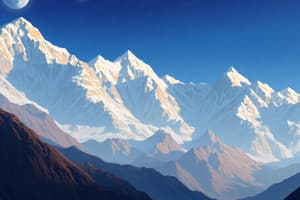Podcast
Questions and Answers
What is the average altitude of the Greater Himalayas?
What is the average altitude of the Greater Himalayas?
- 15,000 feet
- 20,000 feet (correct)
- 10,000 feet
- 25,000 feet
Where are the Shivalik mountain ranges located?
Where are the Shivalik mountain ranges located?
- In the Greater Himalayas
- In the Middle Himalayas
- In the Lesser Himalayas (correct)
- In the Tibetan Plateau
Which region of the Himalayas includes areas of evergreen forests and alpine zones?
Which region of the Himalayas includes areas of evergreen forests and alpine zones?
- Greater Himalayas
- Tibetan Plateau
- Middle Himalayas (correct)
- Lesser Himalayas
What is the average altitude of the Middle Himalayas?
What is the average altitude of the Middle Himalayas?
Which region in India is characterized by sand dunes, thorny scrub, and dry, sparse vegetation?
Which region in India is characterized by sand dunes, thorny scrub, and dry, sparse vegetation?
Where is the Deccan Plateau located?
Where is the Deccan Plateau located?
What role do the Himalayas play in India's geography, climate, ecology, and economy?
What role do the Himalayas play in India's geography, climate, ecology, and economy?
What type of region is characterized by beaches, estuaries, and islands such as Andaman and Nicobar Islands and Lakshadweep?
What type of region is characterized by beaches, estuaries, and islands such as Andaman and Nicobar Islands and Lakshadweep?
Which desert in India covers nearly 70,000 square miles and is characterized by sand dunes and sparse vegetation?
Which desert in India covers nearly 70,000 square miles and is characterized by sand dunes and sparse vegetation?
What type of landscape feature characterizes the Deccan Plateau?
What type of landscape feature characterizes the Deccan Plateau?
Flashcards are hidden until you start studying
Study Notes
Geography of India: A Comprehensive Overview
India, the seventh-largest country in the world by land area, is a diverse and fascinating land that stretches from the snow-capped peaks of the Himalayas to the sun-kissed beaches of the Indian Ocean. Its geography is as varied as its culture, and one of the most prominent features of the Indian subcontinent is the majestic Himalayas.
The Himalayas: A Geographical Marvel
The Himalayas, a part of the greater Himalayan mountain system, stretch over 1,500 miles from the border of India and China to the Tibetan Plateau. They are the world's highest mountain range, with Mount Everest, the highest peak, reaching a staggering 29,029 feet (8,848 meters) above sea level.
The Himalayas can be divided into three main regions:
-
The Greater Himalayas: This region includes the highest peaks, with the average altitude being 20,000 feet. The Himalayas in this region are still in their formative stages, with their peaks still rising and eroding.
-
The Middle Himalayas: This region is characterized by the sub-Himalayan ranges and has an average altitude of 7,500 feet. The climate in this region is diverse, with areas of evergreen forests, deciduous forests, and alpine zones.
-
The Lesser Himalayas: This region extends over 1,500 miles and includes the Shivalik mountain ranges. It has an average altitude of 4,000 feet and is located just below the Middle Himalayas. The climate in this region is moderate, with a warm summer and cold winters.
The Himalayas play a significant role in India's geography, not only in terms of its physical features but also in its climate, ecology, and economy. They provide the country with a unique landscape, including high mountain ranges, river systems, and diverse flora and fauna.
Other Geographical Features of India
Apart from the Himalayas, India is characterized by a wide range of geographical features. Some of the key features include:
-
The Thar Desert: Also known as the Great Indian Desert, the Thar Desert covers nearly 70,000 square miles in the northwestern part of the Indian subcontinent. It is the world's 17th-largest desert and is characterized by sand dunes, thorny scrub, and dry, sparse vegetation.
-
The Deccan Plateau: Located in the southern part of India, the Deccan Plateau is a large, flat-lying region characterized by volcanic rock. The region is home to a variety of ecosystems, including rainforests, grasslands, and wetlands.
-
The Coastal Regions: India has a vast coastline, stretching for over 4,600 miles along the Indian Ocean. The coastal regions are characterized by beaches, estuaries, and islands, including the Andaman and Nicobar Islands in the Bay of Bengal and Lakshadweep in the Arabian Sea.
In conclusion, India's geography is as diverse as its culture, with the Himalayas being a prominent feature. The country's geographical features not only shape its physical landscape but also contribute to its rich biodiversity, climate, and economic opportunities.
Studying That Suits You
Use AI to generate personalized quizzes and flashcards to suit your learning preferences.




